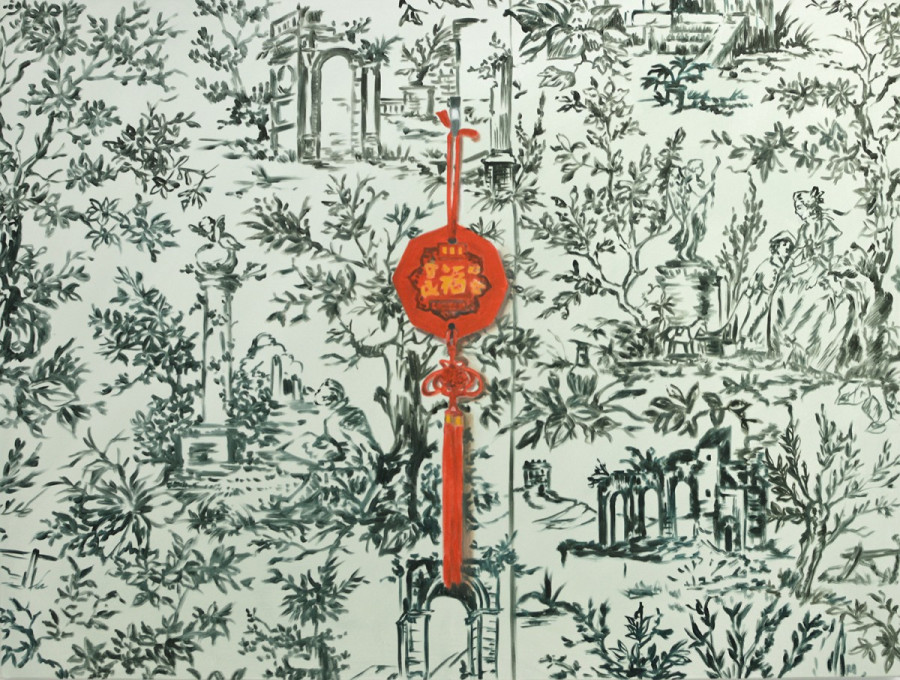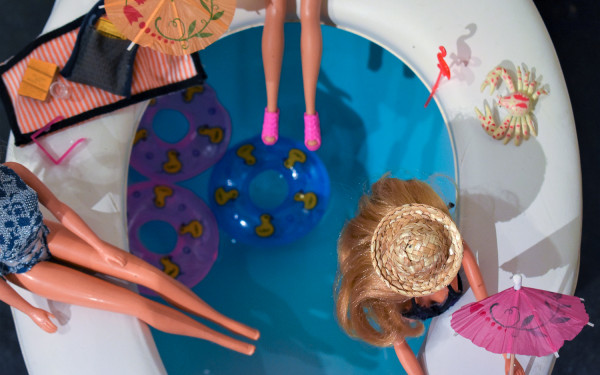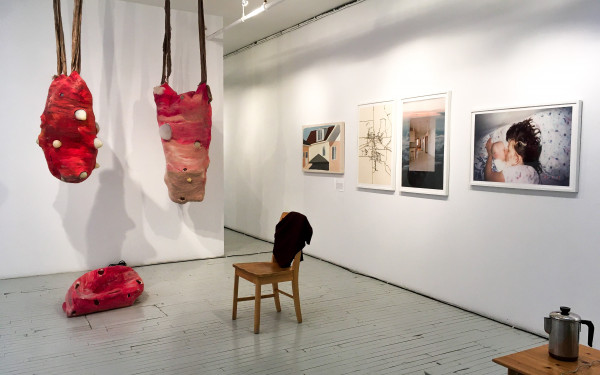Meet Some Artists From Art Matters’ 18th Edition
Concordia’s Art Matters Festival—North America’s largest Undergraduate arts festival—is just around the corner.
Throughout the month of March, the 18th edition of the festival will be taking place all over the city, at locations like Concordia’s VAV gallery, Espace POP on Parc Ave., and Studio XX on Berri St.
This year the festival has teamed up with Nuit Blanche and Festival Art Souterrain, working with over 70 artists to showcase 10 exhibitions. The festival will be comprised of paintings, multimedia creations, sculpture, live performances, video and audio installations, and much more.
Here are six talented and emerging artists featured this year.
Nicholas Ryan
Nicholas Ryan is a music composition student at Concordia who aims to blur the line between Art Matters’ audience and its artists.
Ryan’s piece Quartet (For Four Electric Guitars and Audience) displays four upside down guitars, suspended from the ceiling about four feet off the ground. The guitars have only one string each—the A string—and a device stands by, plucking the string automatically. The audience is invited to tune each guitar at their own will, changing the pitch and collaborating with each other however they please.
His influence for the piece came from Serbian performance artist Marina Abramović, whose 1974 piece Rhythm 0 gave an audience unfettered use of 72 objects on her own body for six hours. The objects ranged from a rose and a feather, to blades and a loaded gun.
The performance culminated with an audience member pointing the gun at Abramović, and another member aggressively intervening.
“For a long time I’ve been trying to figure out a way you could do that with music,” said Ryan. He acknowledges that in Abramović’s piece, the stakes were dangerously high. “I’m kind of ambivalent about doing that with a human being, but doing that with guitars makes me much less ambivalent.”
However, Ryan enjoys handing the audience the keys to his art. “The idea of inviting your audience to control the outcome of a piece—and to accept that—makes you vulnerable to your audience, because they could decide to destroy the piece,” he said.
Ryan hopes for a sense of discovery to come out of his installation. “It would be nice to see a little kid with a parent, trying to tune a guitar, being amused at the way the sounds change,” he said.
His background in composition is very much applied for this unorthodox quartet. “The number is very deliberate. Writing for four instruments is a huge part of learning to be a composer. It is inviting people to take part in that practice who normally wouldn’t.”
Ryan said that he values the engagement of the public in the creation of a piece of music, and breaking down the boundaries between performer and audience.
“I couldn’t think of a better metaphor for being out of balance.”
Ryan’s piece, “Quartet (For Four Electric Guitars and Audience),” opens at Out of Balance at Galerie Espace on March 8, running until the 18th.
Mel Arsenault
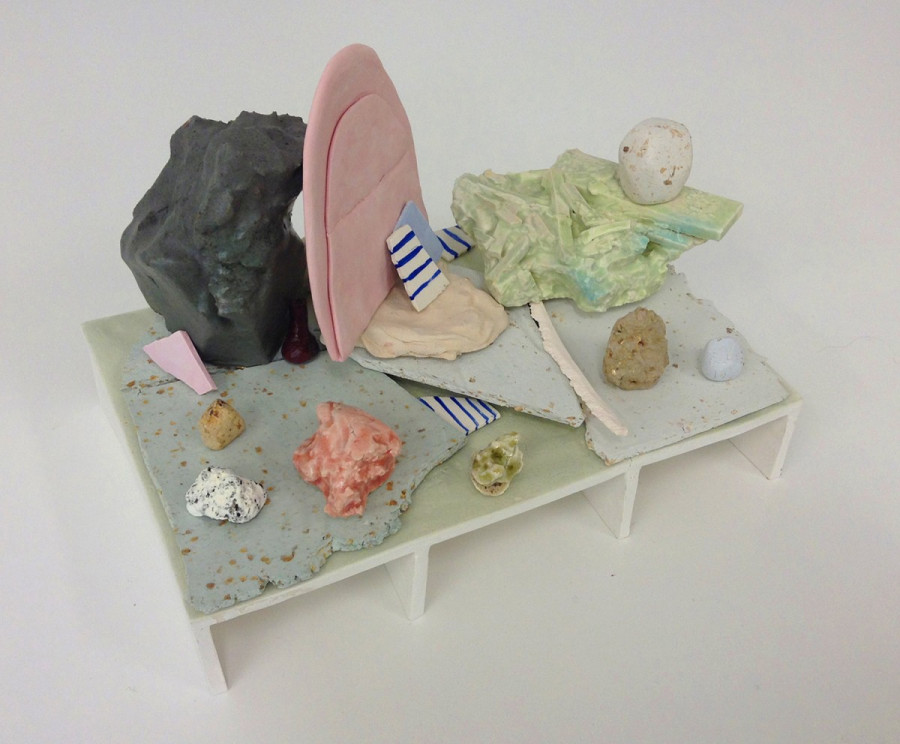
Mel Arsenault is a mixed media artist, mother, and Concordia student.
Her artwork is dynamic, multi-faceted, and abstract. Arsenault paints, draws, uses ceramics, and objects to create scenes exploring the intersections of life, science, and technology. Arsenault is especially fascinated by minerals, and that most everything we use in the modern world is mined, despite the fact that the process is often forgotten about.
A lifelong artist, Arsenault said that as a child she spent all day obsessed with drawing, to the point where her index finger on her dominant hand grew crooked after being hooked over a pencil for endless hours.
“For me abstraction goes back to the universe, and how we think we know things but we don’t,” Arsenault said.“Everything is rightfully abstract, even quantum physics is really abstract. There are so many things we don’t know about. Not knowing relates to abstraction,” explained Arsenault.
Arsenault believes it is “counter creative” to limit herself as an artist to only work with one media. “My work is somewhere between painting, sculpture, and installation,” she explained.
She would rather describe herself as an architect for the way in which she creates meaning out of materials already in existence.
“Are they constructions or being constructed?” she often asks.
Arsenault draws inspiration from her reading material, scientific journals. “I prefer to look at things globally and microscopically,” she explained.
She finds that as she reads, certain sentences will grab her attention and lead to further mental connections that inform her artistic work.
“[I’m] a hyper-physical person,” she said, who is always thinking, reading, and trying to understand how things work. “I’m an artist with a scientific mind.”For a time, Arsenault worked behind a desk doing digital graphic design, which she found to be ultimately unsatisfying and difficult as someone who always wants to be moving around.
She decided to go back to school, counting herself lucky for having a supportive partner, which enabled her to start a bachelor of Fine Arts at Concordia in 2014, the same year of her first stint with Art Matters.
Arsenault will be exhibiting in BLUEPRINTS at the VAV Gallery from March 5 to 16, in collaboration with Festival Art Souterrain.
Florence Yee
Florence Yee’s artwork Trying will take over a section of the Myth Dealing exhibit at Espace POP—12 feet of it, to be exact.
Yee’s work is composed largely of oil painting, but her art has evolved into other mediums.
Her art piece for the exhibit, running March 5 to 18, shows an assortment of red and white rope knots fixed to the wall. These knots, tied in the traditional Cantonese fashion, represent a timeline for Yee.
“These knots kind of serve as good luck charms nowadays, they’ve kind of lost their initial meaning of recording an event. They used to be hung on walls where things happened,” she explained. “But they’re rope and fibre so that doesn’t survive time very well. It’s very ironic that a thing that was meant to record something has kind of disappeared.”
A similar knot hangs in her grandmother’s laundry room. “My grandmother was very close to me when I was young and still is,” she said. Yee learned how to tie the knots with her, which is when she started thinking about the meaning behind the timeline.
“Me and my grandma looked up how to do it on Youtube and learned together. And I was thinking of all the times that she usually speaks to me in Cantonese and I reply in English,” she said.
“I just wanted to kind of go through this wall, make it as a way of acknowledging all the times that I’ve failed to try and respond.”
As she’s felt herself losing her Cantonese over the years, Yee says she’s become emotional over language. Her art serves as a reminder of the importance of trying to hold onto it.
“It was kind of a way of guilting myself into maybe trying to speak more Cantonese.”
“The white knots are also an idea of all the blessings I’ve gotten from people that I’ve either not noticed, or their actions are just so daily and so mundane that you kind of don’t acknowledge it.”
Traditionally, white knots were used at funerals. “So I wanted to make a white knot for that as a kind of mourning for all the things I hadn’t noticed,” she explained.
In the original work, the knots are fixed to the wall with nails, however she was not able to use nails at the exhibition space. Her solution was to use band-aids instead.
“I’m interested in how that will change a bit of what it means. I’m not sure if this is kind of an ironic statement of me trying to band-aid this thing that I obviously cannot fix anymore, or is it that I am trying to still fix it but maybe I can still do it?”
Yee will be exhibiting at Myth Dealing at Espace POP from March 5 to 18, and Tender Teeth at Mainline Gallery on March 8.
“I’m really glad and fortunate to be accepted and I’m excited to be involved. […] It’ll be a good opportunity to meet people and see who’s here.” —Sophie Wonfor
Matt Halpenny
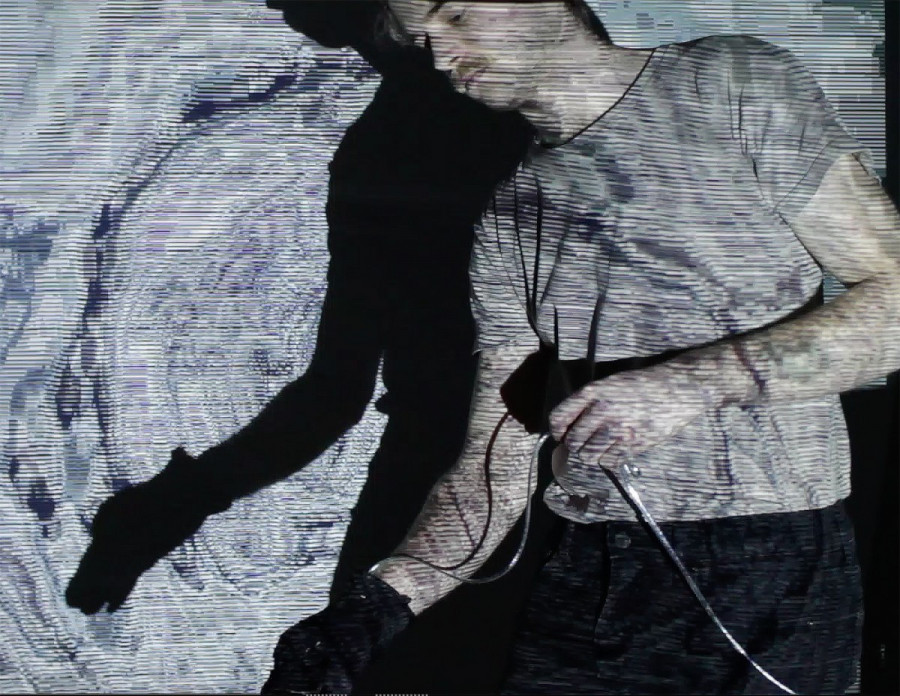
Matt Halpenny is an interactive media artist who navigates “the intersection between art and science.”
Halpenny has previous experience making music, but when they began studying computational arts at Concordia they felt inspired to begin a new form of artistic practice.
Some of the knowledge that they use for their artwork, such as coding, is partly self taught and built off material learned in class.
Halpenny studied biology, chemistry, and physics at Concordia, but found it dry, close minded, and rigid.
“My whole life I’ve been very interested in the scientific aspect of things and how they work on a fundamental level,” said Halpenny.
Their piece in Art Matters is called Conductivity Gloves and uses a “wearable technology glove” to create “gestural performances that are […] lost within electronic music these days,” they explained.
Conductivity Gloves aims to question the paradigm of musical performance in modern society, and “the technology influences how the piece is built.”
Halpenny explained that their project started off with the glove and a few sensors. Then they built the software for it, experimented with code, tested out an initial performance “in a small intimate setting,” inviting two other musicians to perform with them so that the experience was unique to the viewers each time.
Halpenny is interested in the way that people interact with technology, and how scientists and artists can collaborate together to produce work.
“When you’re working with technology you’re creating a new experience for each participant. It’s constantly in flux, which creates a whole new way of interpreting the art, because you can’t just rely on the same things every time. It’s performative, even if there are no performers,” said Halpenny.
There is irony in the fact that Halpenny uses technology in pieces meant to critique it.
“It’s one thing to talk about how technology impacts us, but I feel that it’s another thing to actually use technology,” Halpenny explained, “ because it has more of an impact that people can see. It’s not about anti-technology, it’s about critically thinking about technology.”
“I’m pretty excited about it, this is the first time I’ll be presenting anything in an exhibition setting,” said Halpenny about showing their work at Art Matters.
Their work will be on display at (Dis)CONNECT at Espace Pop on March 3 from 7 p.m. to 1 a.m.
Roxa Hy
“I make the objects perform.”
Roxa Hy is an artist blending her background from Concordia’s theatre program with installation art and humour to start a conversation at Art Matters 2018.
Set at GHAM + DAFE, a gallery in Hochelaga, Hy’s Good Thing You’re Wearing Sunglasses aims to make the audience think about gentrification in the rapidly developing neighbourhood. But Hy’s work is not meant to be conclusive or educational, simply meant to open a dialogue in the community.
“I’m not trying to educate the audience, I’m not trying to prove anything, that’s really not the point. I’m just trying to talk, or just have a conversation,” she said.
The piece involves a smooth voice which guides the audience through the experience through headphones. Hy also works to explore methods of audience participation, and ensures that the audience plays a significant role in the installation. In a previous collaborative work called Ça a l’air synthétique ok bye she asked, “How do you make that relationship playful and professional?”
Her group ended up paying audience members from the budget for the piece to perform tasks in a scene. The result is an absurd, amusing scene that comes off as lighthearted. And she said Sunglasses will have the same vibe.
“A lot of the work that I do is aware of its structure,” she continued.“It’s an anglophone school presenting work in a gallery that’s in Hochelaga, a neighbourhood that’s being gentrified so quickly right now.”
Hy will offer the show in French and English, using her first language to appeal to the francophone neighbourhood.
Although much of the details of Good Thing You’re Wearing Sunglasses are shrouded in obscurity, its purpose may be as obscure as its form. It will be interesting to see how different audiences produce different experiences for observers.
Hy got involved as an artist at Art Matters in 2015, followed by the role of curator and co-director the following year. As Hy looks forward to working with a dance centre and bringing her solo experience to future collaborations, she sees Art Matters as a formative experience in her career.
“My experience at Art Matters incredibly shaped the way I’m entering the art world now,” she said.
Hy will be at GHAM + DAFE for The Art of Sinking from March 12 to 24.
Sophie Wonfor
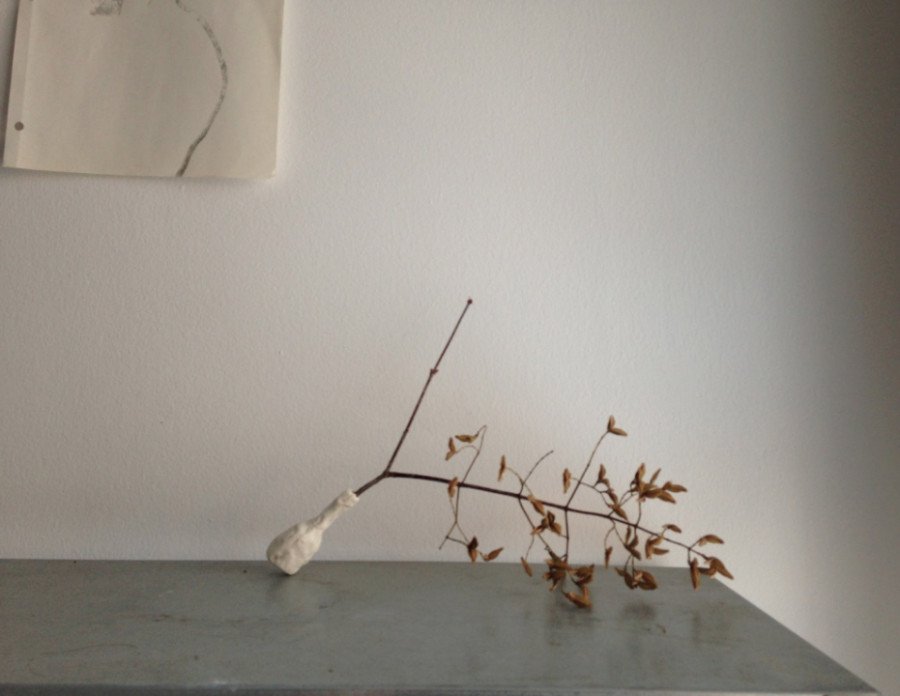
Sophie Wonfor likes plants.
She thinks about gardening a lot, and about running a nursery with her sister. For her, flower arrangement is an esteemed art form.
The artist, who primarily focuses on drawing and writing, also uses plants in her practice, creating simple arrangements that delve into the language of plants, using them to convey human concepts and emotions.
“I’ve been interested for a long time in trying to use the inherent language I think that exists within plants and the gestures they make,” she said. “We impose […] our own reading onto that, but I’ve been interested in working with plants, talking about them but with them themselves.”
She’s fascinated by the relationships people cultivate with plants. “The way that taking a plant out of context changes everything and we see it [differently] and have this personal relationship with it, I find that interesting,” she expanded.
Her artwork Here to be held and how else, when to be held is to be helped is a delicate arrangement of branches taped and tied together.
“This project is thinking about ideas about support and care, like holding each other up.” she explained.
The artwork will be installed low to the ground in a corner of the exhibition space. Wonfor said that is the perfect spot for her artwork, as it mirrors the gentleness of it.
“I like the idea that someone might walk by it because I don’t want to take up a lot of space and I think that my work is quite quiet,” she said. “So you have to approach it, I think, from a certain attitude to really get anything from it.”
Since moving to Montreal just over a year ago, this will be her first time being exhibited in this city, and the first time she’s involved with Art Matters.
“I’m really glad and fortunate to be accepted and I’m excited to be involved, because I’m still in many ways kind of settling in and figuring out life and school here. It’ll be a good opportunity to meet people and see who’s here.”
Wonfor’s work will be shown in the exhibit it’s all i have to bring today running March 8 to 24 at Studio XX.

